Extensive compressor reviews and FAQ


How do different cables handle transient spikes?
After I posted the results of spectrum analysis of several cables, various "defenders" of high-end cables responded "oh well spectrum analysis doesn't show how a cable handles the notes, how cleanly it transmits transient peaks, how accurately it retains harmonic detail, how quickly it recovers after a big spike of amplitude, the impact of the notes..." They also talked about how inferior cables will "smear" the tone, they will lack resolution, sound muddy, or otherwise do a worse job of transmitting your signal. So I decided to test those claims.
What we're talking about is distortion. The technical definition of distortion is when the output of a device is in any way different from the input. It doesn't mean "distortion pedal" buzzing sounds, or even soft clipping necessarily. It just means "was there any change at all". A cable that handles transient spikes better, or retains harmonic detail better, would by definition have lower distortion. Distortion can be measured.
First I tested the cables with a Hewlett Packard 8903B Audio Analyzer, using an amplitude of 6 volts and three different frequencies. The cables were coiled inside a grounded mu-metal container with 1 mm-thick walls, to minimize external influences on the reading. All but one of the cables measured the same: 0.0029% at 20 KHz, 0.0017% at 5 KHz, and fluctuating around 0.0025% at 30 Hz. These are incredibly low amounts of change to the signal. At lower test-signal voltages, the distortion was a bit higher, but it was the same at all frequencies. The one exception was the Atlantic Zerocap, that had higher distortion when its active (powered) component was switched on; with that component switched off, the cable had the exact same distortion as all the others. So just with the readings of this analyzer we could reasonably suggest there is no difference in how any of the cables transmit signals.
Next I ran an electronic kick-drum beat through the cables at about 30 V p-p. This is a huge signal spike, much higher than any bass or guitar will put out, and it tests all of the claims about low-frequency handling, transient response, recovery time, and so forth. I recorded the results with an oscilloscope, with channel 1 (yellow) being the signal at the beginning of each cable, and channel 2 (blue) being the signal at the other end. Here are the results:
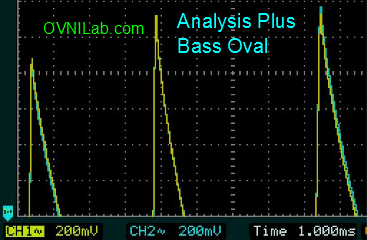
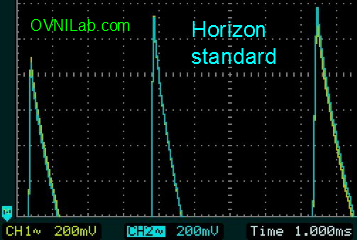
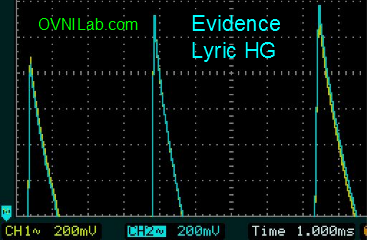
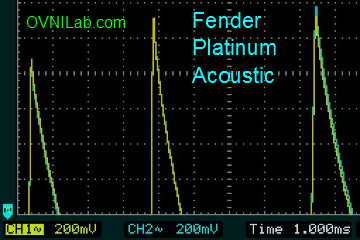
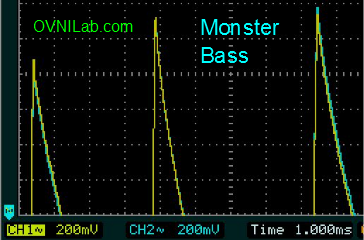
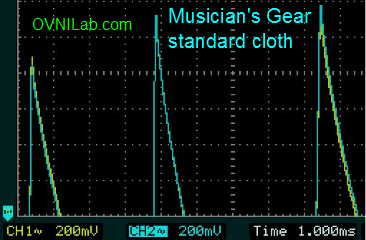
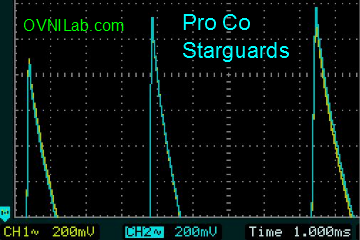
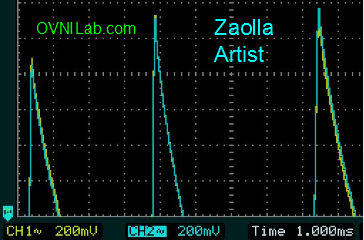
Clearly, they are all identical, and the signal at the output is identical to the signal at the input--the blue line exactly overlaps the yellow line, to the point that in some cases we can't even see that there are two separate lines. These images show a close-up view of milliseconds of wave peaks. Any variation in the delivery of the signal would result in the blue line separating from the yellow line. If the transients were "slower" then the blue line would be displaced horizontally, and if the signal was "weaker" then the blue line would be displaced vertically. If there was any failure to deliver perfect resolution and harmonic detail, the shape of the blue wave would be different from the yellow one. Instead, what we see is that the very cheapest cables and the very most expensive cables deliver the signal perfectly equally.
On the Analysis Plus website they have a video titled "Make me prove it", purporting to give proof that their cable performs better. In this video they show the waveforms of two tracks recorded in Protools, one with the Analysis and one with some other cable. They show that the Analysis track has bigger waves, and as the salesman puts it, "more dynamics in between the notes!" Looks great, right? But the tracks were recorded separately. All he had to do was play with just a tad more enthusiasm while recording with the Analysis cable, and the result would be larger waves with more dynamic range. He wouldn't even have to do it consciously--if he just "felt better" while using his own cable, it could make him play with just enough more zest to get exactly the results shown onscreen. The only thing it proves is that either they consciously made the choice to try to fool you with a fake demonstration, or they have so little actual scientific understanding that they didn't realize they were giving a fake demonstration. The "white paper" they produced raises the exact same either/or question: do they genuinely not know that transmission-line theory doesn't apply to non-transmission-line situations, or are they deliberately counting on the fact that most people don't know the difference?
Click here to return to the reviews of various different brands and models of cable.
Click here to return to the spectrum analysis.

nothing to see here
All text on this page written and owned by Cyrus Joaquin Heiduska, 2006-2024, all rights reserved.
Copying is prohibited, and AI scraping or training is prohibited. Instead, please link to this page using the link text "compressor reviews".
PRIVACY POLICY